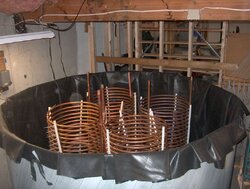Hi,
I'm using an EKO 25, this is the first year and so far it works pretty well, but I need it to work more efficiently. I hate waking up at 6:00AM to find my fire is out. I load the dam thing like 3 to 4 times a day. From what I understand, with storage, it will increase the efficiency of how this whole thing works. I was wondering, where to people go to find a storage tank? My boiler is located in the basement; I do not have a walk in basement, only a bulk head. So I'm worried that I'm not going to be able to get a big enough tank down there. And someone point me in the right direction?
Rick
I'm using an EKO 25, this is the first year and so far it works pretty well, but I need it to work more efficiently. I hate waking up at 6:00AM to find my fire is out. I load the dam thing like 3 to 4 times a day. From what I understand, with storage, it will increase the efficiency of how this whole thing works. I was wondering, where to people go to find a storage tank? My boiler is located in the basement; I do not have a walk in basement, only a bulk head. So I'm worried that I'm not going to be able to get a big enough tank down there. And someone point me in the right direction?
Rick


